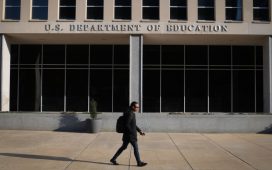Wednesday, March 29, 2023
Media Contact:
Mack Burke | Associate Director of Media Relations | 405-744-5540 | mack.burke_iv@okstate.edu
Oklahoma State University’s Dr. Jamey Jacob testified at the Capitol before the United
States House Committee on Science, Space and Technology on March 23 in Washington,
D.C., highlighting the need for continued investment in drone research for the benefit
of national defense, technology development and the public good.
The meeting served as the legislative hearing for The National Drone and Advanced
Air Mobility Act, a bill introduced by Rep. Frank Lucas from Oklahoma’s Third Congressional
District that aims to provide for a coordinated federal initiative to accelerate civilian
unmanned aircraft systems along with advanced air mobility research and development
to strengthen economic and national security.
As executive director of the Oklahoma Aerospace Institute for Research and Education
(OAIRE), director of the Counter-UAS Center of Excellence and professor of mechanical
and aerospace engineering at OSU, as well as president of the Unmanned Systems Alliance
of Oklahoma, a chapter of Association for Uncrewed Vehicle Systems International (AUVSI),
Jacob continues to be a thought leader in unmanned drone technology, an industry with
major implications for national defense, emergency response and commercial enterprise.
See Jacob’s full written statement to the committee below and follow this link to
see the full hearing: https://www.youtube.com/watch?v=X-jZG_gLeNg.
Written Statement of Dr. Jamey Jacob
Executive Director of Oklahoma Aerospace Institute for Research and Education
Williams Chair and Professor of Mechanical and Aerospace Engineering
Oklahoma State University
Before the Committee on Science, Space, and Technology
March 23, 2023Chairman Lucas and Ranking Member Lofgren:
Thank you for inviting me to testify today. It is an honor to speak with you about
the work underway within the state of Oklahoma to help advance emerging technology
in the US in advanced air mobility (AAM) and safe integration into the national airspace.
In addition to serving as the Executive Director of the Oklahoma Aerospace Institute
for Research and Education, I also serve as Director of the Counter-UAS Center of
Excellence and as Professor of Mechanical and Aerospace Engineering at Oklahoma State
University, as well as president of the Unmanned Systems Alliance of Oklahoma, a chapter
of AUVSI.
Since development of laboratories for autonomous and remotely piloted aircraft in
the 90s for undergraduate teaching tools, Oklahoma State University has been a leader
in aerial robotics. As of part of our land grant mission, we have fostered education,
research, outreach, and application of these systems into areas of public use, such
as agriculture, energy, environmental monitoring, and national defense, working with
national labs and industry alike.
We have used this technology to help spur interest in aerospace and other STEM careers,
particularly for under-represented minorities including urban areas and tribal nations,
leveraging programs within the Choctaw, Cherokee, and Osage Nations of Oklahoma, providing
new opportunities for these sovereign nations to use this technology to support their
tribal members and develop new entrepreneurial activities within their borders and
support their federal customers.
As examples of our use inspired research and development, we are working with the
FAA to develop technology to add in navigation and flight inspection, improving performance
and reducing cost to keep US airports and aerial navigation safe; with NASA to develop
deployable aircraft to explore Mars and balloons to explore Venus; with national labs
to evaluate the efficiency of wind farms; oil and gas companies to search for new
American energy sources and find sites of fugitive emissions to safeguard precious
natural energy resources and protect the environment; evaluate systems to inspect
crops and livestock and eradicate feral hog infestations; survey lakes and rivers
to mitigate invasive species, protect endangered ones, and measure outbreaks of diseases
and blooms; search for wildfires in rangelands and forests, protecting grasslands,
forests, and the firefighters and forest rangers that preserve them; developing systems
to monitor at-risk marine mammals such as dolphins and whales; and working with international
partners such as Bombtechs without Borders to find and dispose of unexploded ordnance
within active combat zones, including Ukraine. These are just some examples of the
projects that our creative researchers and students are currently working on.
Of critical national importance is OSU’s Counter-UAS Center of Excellence. Supporting
the needs of both the Departments of Defense and Homeland Security, the Counter-UAS
Center of Excellence works with private companies to evaluate threats of drones by
state and non-state actors using the systems as both symmetric and asymmetric weapons
threating US warfighters and the public, as well as evaluating systems to detect,
identify, and mitigate these threats. In addition to developing the gold standards
to evaluate these defensive systems, the Counter-UAS Center of Excellence is currently
working with the US Army to develop curricula and training capabilities for the DoD
Joint Counter-UAS University, housed at Fort Sill, to train solders in Counter-UAS
technology across all branches of the military to help bridge the gap in knowledge
and training.
Federal support has been the catalyst to enable this use inspired research. Government
funding has been a powerful driver in pushing technology from the laboratories to
end-user adoption, crossing the valley of death that many innovations never bridge.
Support from programs such as the NASA University Leadership Initiative and National
Science Foundation National Robotics Initiative, has allowed us and other universities
to push the boundaries in using UAS to improve wind and weather observations and forecasting,
which will result in adoption of AAM solutions in urban setting, and greatly increase
our capability to accurately predict severe storms, saving lives and property. The
NASA University Leadership Initiative is an example of transformative research support
as it aims to unite NASA’s Aeronautics Research Mission and prominent American research
universities to produce innovative ideas that allow university and industry teams
to provide unique solutions to the most complex problems facing aeronautics today.
Technological progress depends on the fundamental discoveries in the university and
national research labs and resulting translation to innovation that small businesses
and entrepreneurs excel in, and the scalability to consumer products provided by larger
global companies. Without the public investment from federal research funding, the
risks are too great for private investment alone to develop breakthrough technology
needed for cutting edge products and new high-tech jobs.
As an example of this, through EDA funding, in cooperation with private and tribal
partners, we have founded the LaunchPad AAM Center and Flight Range with the Osage
Nation and Tulsa Innovation Laboratories to develop novel programs to support small
business innovation and provide unique flight-testing solutions, helping to bridge
this divide.
To maintain the US lead in this technology requires continued support of academic
research funding and increased collaboration between universities and private industries,
allowing collegiate laboratories to shoulder the burden of high-risk fundamental research
and development and allowing US entrepreneurs and the American people to profit from
the rewards that this research generates.
The U.S. heartland — flyover country — has often been ignored in favor of coastal
concentrations that traditionally receive the bulk of research funding. However, East
and West Coast states generally lack the access to open low risk airspace afforded
by low populations, generating potential new opportunities by utilizing flyover country
as fly-in research ranges. This too requires support by federal funding.
Facilities such as the Choctaw Nation of Oklahoma test site as part of the FAA BEYOND
program are critical to US capabilities. Further development of these and other facilities
that allow testing of this technology to evaluate use cases and performance is much
needed to provide crucial safety data for the FAA, such as advancing beyond visual
line of sight drone operations and routine cargo deliveries of critical supplies for
first responders, disaster response, medical emergencies, and impoverished regions.
These new inventions have been developed through public private partnerships – combinations
of government funding, private investment, and academic research and development from
research labs across the country. This driver of innovation is a powerful engine for
economic growth and one of America’s greatest competitive strengths.
We are in a new golden age of aviation. Like the previous golden eras that preceded
this in the 1920s and post WWII, this new era witnesses the introduction of new technology,
in this case autonomy and electrification, that will have a tremendous impact on the
US and how individuals use aerial transportation for travel and commerce. This era
that we are in the process of birthing will have an even wider reach than the two
that went before.
We believe the future of advanced aviation is bright, and that the quality of life
for all Americans can be enhanced by advancing and exploiting this emerging technology.
Research conducted at land grant and other universities play a critical role in this
potential prosperity, but we require the federal government’s support to ensure that
these technologies flourish and provide the benefits to society that we know are possible.
Thank you again for inviting me to share my opinions. I will be happy to answer any
questions that you may have.










